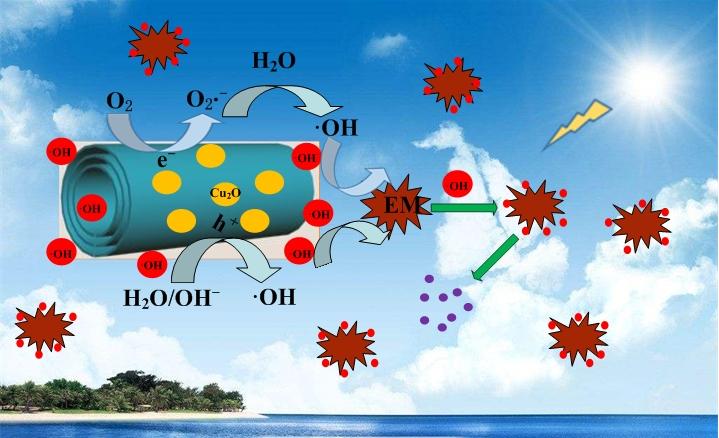Enhanced photocatalytic activity by Cu2O nanoparticles integrated H2Ti3O7 nanotubes

The suggested mechanism of photocatalytic oxidization of EM over Cu2O@H2Ti3O7 nanocomposite under sunlight irradiation. Under the sunlight irradiation, photo-generated electrons (e?) of nanocomposite aggregated on nanotubes, and holes (h?) aggregated on Cu2O nanoparticles, which will reduce the bandgap energy and prolong the effective separation of photo-induced electron-hole pairs, enhance eventually the photocatalytic activity. It causes a large number of the hydroxy radical groups (·OH) generated on nanocomposite, which will effectively oxidize EM due to the synergistic effect between them to form heterojunction structure. Therefore, nanocomposite exhibits the excellent photocatalytic performance. Credit: NANO Journal
Current hydrodesulfurization (HDS) technology is hard to remove thiols and refractory thiophenic compounds to a minimum in fuels. Moreover, the HDS technology requires severe operation conditions, along with other disadvantages in deep desulfurization.
Therefore, considerable attention has been paid to non-HDS techniques, such as adsorption, biodesulfurization and photocatalytic oxidation, etc. Among them, the photocatalytic oxidation desulfurization is the most ideal “green chemistry” technology for deep desulfurization with mild operating conditions. Some researchers have reported nanocomposite as an effective photocatalytic functional material than the host alone, such as Nb6O17@Fe2O3, Cu2O@TiO2 nanotube arrays, etc.
Titanate nanotubes attracted a wide attention for the high photocatalytic activity under UV light irradiation. However, titanates have a relatively wide band gap and is utilize only under UV light, thus the photocatalytic activity is limitation.
Moreover, when Cu2O is used as a photocatalyst alone, it is a limitation what the electrons and holes excited by light cannot be transferred efficiently and are easy to recombine. Some team of researchers introduced an innovative strategy by compositing Cu2O nanoparticles with titanate nanotubes, which will result in the stronger visible spectral response and wider absorbance.
This technology provides a new approach to reduce the bandgap energy and prolong the separation of photo-generated electron-hole pairs, which resulted in better photocatalytic activities for photodegradation of organic pollutants more thoroughly.
The most significant aspect of my study: Composting Cu2O nanoparticles with H2Ti3O7 nanotubes as an effective photocatalyst applied in desulfurization, it was rarely reported that the construction and desulfurization application of this functional materials before we research. At first, the photocatalytic oxidation desulfurization is the most ideal “green chemistry” technology for deep desulfurization with mild operating conditions than the current HDS technology.
Next, We have synthesized the trititanate nanotubes. Previous researches demonstrated that some layered titanates were better photocatalysts, and the corresponding nanosheets and nanotubes even showed much higher photocatalytic activities than the original layered compound. In addition, we have constructed the Cu2O@H2Ti3O7 nanocomposite, the mesoporous nanoscroll composites possess obviously higher photocatalytic activities than guest oxide nanoparticles or host layered materials alone.
The researches suggest that layered materials doped with guest nanoparticles can not only reduce the bandgap, but also inhibit the recombination of photoinduced electron-hole pairs. Therefore, we employ Cu2O nanoparticles integrated H2T3O7 nanotubes by a facile hydrothermal method, it shows that nanocomposite exhibits the excellent photocatalytic performance due to the stronger visible spectral response and wider absorbance, this research that could help develop new energy resources (solar energy) and oxidize organic pollutants for protection of the environment.
###
This work was supported by the National Natural Science Foundation of China (No. 21271008, 21071004).
Addition co-authors of the paper are Lei Xu, Jie He, Lifang Hu, Bin Wang and Liangguo Da, they all come from Anhui University of Science and Technology.
Corresponding author for this study is Jie He, jhe@aust.edu.cn.
This research (http://www.
Media Contact
All latest news from the category: Life Sciences and Chemistry
Articles and reports from the Life Sciences and chemistry area deal with applied and basic research into modern biology, chemistry and human medicine.
Valuable information can be found on a range of life sciences fields including bacteriology, biochemistry, bionics, bioinformatics, biophysics, biotechnology, genetics, geobotany, human biology, marine biology, microbiology, molecular biology, cellular biology, zoology, bioinorganic chemistry, microchemistry and environmental chemistry.
Newest articles

Webb captures top of iconic horsehead nebula in unprecedented detail
NASA’s James Webb Space Telescope has captured the sharpest infrared images to date of a zoomed-in portion of one of the most distinctive objects in our skies, the Horsehead Nebula….

Cost-effective, high-capacity, and cyclable lithium-ion battery cathodes
Charge-recharge cycling of lithium-superrich iron oxide, a cost-effective and high-capacity cathode for new-generation lithium-ion batteries, can be greatly improved by doping with readily available mineral elements. The energy capacity and…

Novel genetic plant regeneration approach
…without the application of phytohormones. Researchers develop a novel plant regeneration approach by modulating the expression of genes that control plant cell differentiation. For ages now, plants have been the…





















